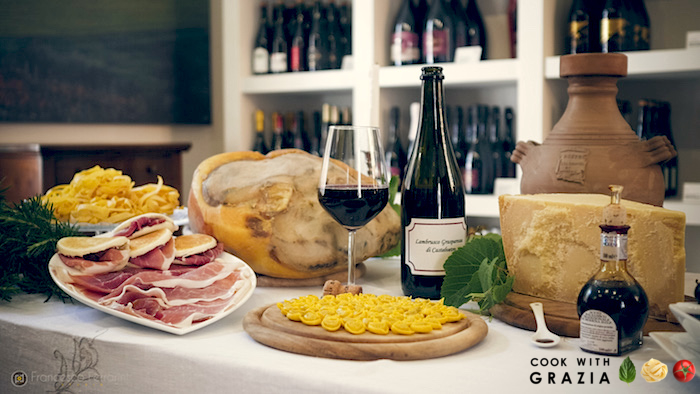Balsamic vinegar has become quite popular among chefs, amateur cooks and foodies. But how do you exactly use balsamic vinegar? How do you select, use and store this precious ingredient?
To explain, we need to take a step back. In fact, there are many different kinds of balsamic. The subject is actually quite complicated even for an expert.
But to simplify, you really need to know that there are three main categories of Balsamic vinegar. Each has its own characteristic taste and therefore suitability for specific culinary uses.
-
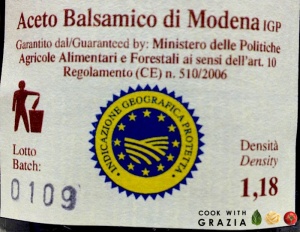
IGP blue label
IGP balsamic vinegar, awarded by the European IGP blue seal (IGP is Italian for Protected Geographical Indication), is a very large category of balsamic vinegars. Being labeled IGP means that the production process must follow a specific set of rules. For example, only three ingredients are allowed: vinegar, must and caramel. Also, the IGP requires a minimum aging time of 60 days. In addition, at least one phase of the production process has to occur in the Modena or Reggio Emilia provinces. This vinegar is usually affordable and can be your everyday balsamic, as a more sophisticated alternative to regular wine vinegar.

Acclaimed Italian pastry chef Serena Paioli won a special prize with this dessert made with balsamic vinegar, raspberries and chocolate
Balsamic vinegar has a deep brown color, it’s glossy and transparent, and sometimes is somewhat denser than regular vinegar. It has a bittersweet, slightly acetic and aromatic flavor. If the IGP balsamic vinegar is aged for more than 3 years, the word “Invecchiato” is added to the label. With aging, the IGP balsamic vinegar’s taste becomes more complex, acquiring perfumes depending on the type of wood barrel it was aged in.
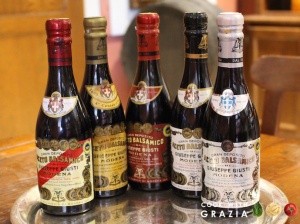
Giuseppe Giusti, probably the oldest balsamic vinegar maker in Modena (dating back to 1600), produces some of the finest IGP balsamic vineagars
As the IGP balsamic vinegar ages, its consistency and perfume become closer those of DOP Balsamic, and it can be used in the same way as a DOP balsamic. But remember: the IGP labeling system requires only 60 days of aging (or at least 3 years for the “invecchiato” kind). Balsamic vinegar can also be aged for longer time, but the IGP labeling system doesn’t allow any further statement than “invecchiato” on the label.
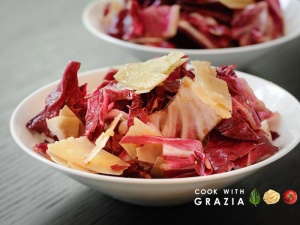
This salad recipe is included in my 20 minute-recipe App Cook with Grazia and requires aceto balsamico IGP
IGP balsamic vinegar is used in salads, marinades, and as an ingredient in recipes. Some restaurants prepare “reductions” by slowly cooking the IGP balsamic vinegar on the stove until it reaches a denser consistency. This reduction is also less acidic in taste, closer to the DOP balsamic vinegar but much cheaper, allowing restaurants to use it as they would DOP balsamic.
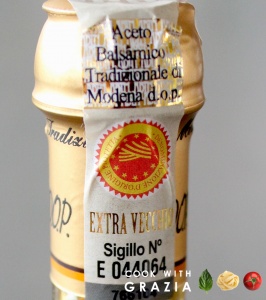
DOP red seal for balsamic vinegar
2- The Aceto Tradizionale di Modena (or the Aceto Tradizionale di Reggio Emilia), awarded with the stricter DOP (Product Denomination of Origins) European red seal, is a very different food specialty. There is no doubt that this is the very best among Balsamic vinegars on the market. It represents just a small percentage of the Balsamic vinegars sold, and in the US, it is available only in select stores. The Aceto Tradizionale di Modena is of a full dark brown glossy color.
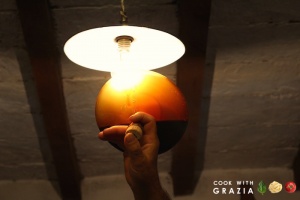
DOP balsamic vinegar is dark brown in color and has an almost sirupy consistency
It has a velvety, syrupy consistency, and it’s smooth, penetrating, with a complex aromatic bouquet, sweet and sour, with alluring acidic undertones. Its production process is strictly regulated; the process itself is truly unusual, interesting, and very different even from the IGP Balsamic vinegar.
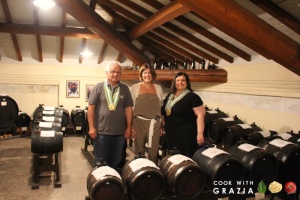
Grazia between Cristina Sereni and Dino Stefani, maestri acetai (master vinegar makers) at the Traditional Balsamic Vinegar Museum. Spilamberto, June 2015
“Regular” Traditional DOP Balsamic vinegar is labeled “Affinato” and must be at least 12 years or older, whereas Traditional DOP Balsamic vinegar is 25 years or older and is labeled “Extravecchio.”
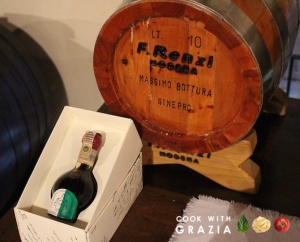
Chef Massimo Bottura’s Balsamic Vinegar is aging at the Museo dell’aceto Balsamico Tradizionale in Spilamberto.
The DOP labeling system does not classify Balsamic vinegar any further: there is no younger than “12 years or older,” and no older than “25 years or older.” In fact, even if in principle the oldest the balsamic is the best, there are many other production-related aspects that can influence the flavor of balsamic vinegar. While you can taste the difference between an “Affinato” and an “Extravecchio,” only very discerning palates can detect differences and nuances after 25 years of aging. The DOP from Modena is sold only in specific bottles designed by Giugiaro, whereas the DOP from Reggio Emilia is bottled in upside-down bell-shaped flasks.
 Franco Satrioni showing off his many medals and prizes. He is a tiny producer – he only makes a little over 2 gallons of DOP per year. |
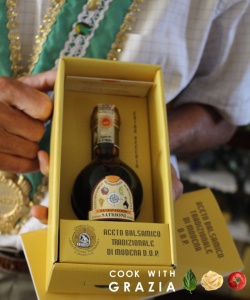 Traditional balsamic vinegar from Modena comes in a specific bottle designed by Giugiaro. This is Satrioni’s pluri-medaled Extravecchio DOP. |
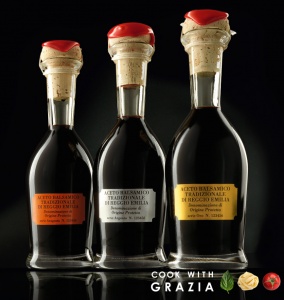 Traditional balsamic vinegar from Reggio Emilia is produced in a similar way but bottles have a different shape. The overall production is much smaller than Modena’s. |
The DOP Traditional Balsamic vinegar is quite expensive.
As a rule, use this magnificent, superb condiment uncooked, as a finishing touch on dishes. Adding a touch of DOP Balsamic vinegar only at the very last minute or at the very last step of a recipe will allow you to fully savor the complexity of flavors.
The more acidic Affinato is said to be best on top of richer dishes, but it is truly a matter of taste.
This condiment is used on top of almost any dish, from antipasti to desserts.
Here are some ideas:
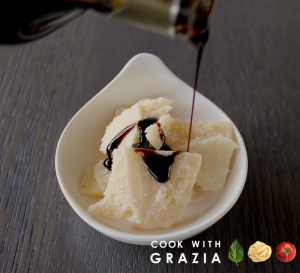
DOP balsamic vinegar on top of Parmigiano-Reggiano
A typical aperitivo starts with chips of Parmigiano-Reggiano sprinkled with Aceto Balsamico Tradizionale, but really any cheese would be perfect with it, as well as freshly sliced Prosciutto di Parma or Prosciutto di Modena DOP.
The Aceto Balsamico Tradizionale is the ideal final touch on a plate of tortelli, ravioli, gnocchi, and risotto. It works great over velvety, delicate vegetable soups.
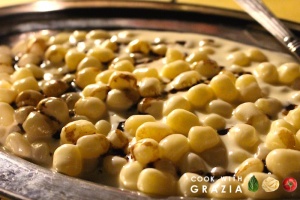 DOP balsamic vinegar on top of gnocchi |
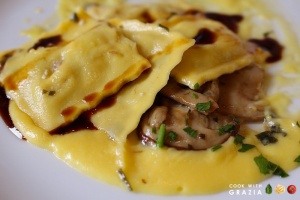 DOP balsamic vinegar on top of ravioli |
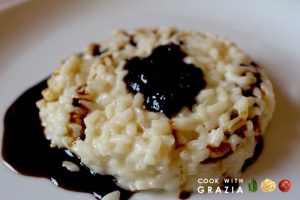 Traditional balsamic vinegar on top of risotto |
It’s fantastic on top of grilled or roasted meats, or bollito (boiled meats) and even with fish and shrimp dishes.
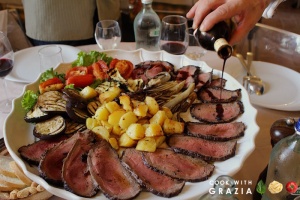
DOP balsamic vinegar on top of roasted meat
A touch of Aceto Balsamico Tradizionale can bring raw meat or fish (from carpaccio to tartare) to the next level.
Aceto Balsamico Tradizionale can boost the taste of eggs: poached, over-easy or in frittata.
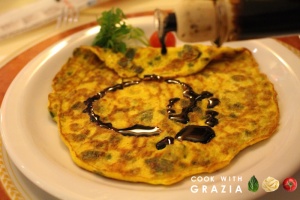
DOP balsamic vinegar on top of frittata
It’s absolutely irresistible on top of fully ripened, sweet strawberries, vanilla ice cream or dark chocolate of the best kind.
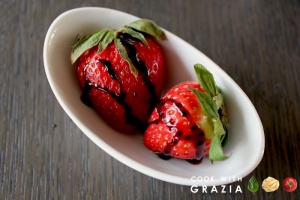
DOP balsamic vinegar on top of strawberries
Are there dishes that don’t pair well with Aceto Balsamico Tradizionale? Yes: avoid using it on top of dishes with an already strong personality. Think of caviar, truffles, or spicy and hot dishes.
3- Other non-IGP or non-DOP Balsamic vinegars. This is the “Wild West,” where you can really get lost. In this category (probably the largest), you can find truly excellent Balsamic vinegars, family productions that are made following the best DOP practices but are not sold on the market. Others sometimes choose production techniques outside the DOP-IGP strict set of rules, perhaps by having different aging time and methods, or by adding flavorings to the Balsamic vinegar (often berries and other fruits, and they are then called condiments, not balsamic vinegar). You can also incur in total… fakes.
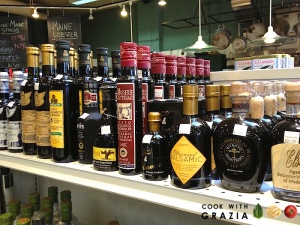
Choosing balsamic vinegar can be difficult! DOP and IGP labels provide a good safety net.
You will then have to carefully choose your product and decide for yourself how to use it.
How to store:
IGP and DOP Balsamic vinegars do not expire. Store it in the panty, in its bottle, closed with a stopper, and you can enjoy it virtually forever. The only exception might for non-IGP or DOP Balsamic vinegars, if there are ingredients listed, besides must, vinegar and caramel), which can deteriorate the product.
Disclaimer: all photos are from Grazia Solazzi except for:
- Featured image and DOP balsamic vinegar with backlight, provided by PR offices in Spilamberto and Castelvetro
- Reggio Emilia DOP balsamic, provided by Consorzio Tutela ABT-RE

